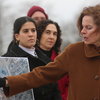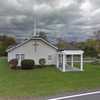Altamont Planning Board approves cell tower for Agawam Lane
ALTAMONT — The planning board on Monday approved a controversial special-use permit for the construction of a 120-foot monopole telecommunications tower on a parcel of village-owned land at 23 Agawam Lane.
With planning board member Wayde Bush and alternate Connie Rue absent from the meeting, Chairman Tim Wilford and board members Stephen Caruso, Deborah Hext, and John Hukey voted to approve the special-use permit for Enterprise Consulting Services.
Wilford said he thought the village board could have done a better job in handling the matter but he favored allowing the tower to improve communications for first responders like the fire department.
The board added four conditions to the special-use permit application that ECS, in order to obtain the permit, agreed to. Enterprise Consulting Services will:
— Waive all rights under federal law to extend the tower’s height.
The Federal Communications Commission allows a tower owner to increase the structure’s height by as much as 20 feet without having to give any type of notice to residents or municipalities that the increase will happen.
ECS waived that right and agreed that any future height change would require a special-use permit, subject to planning board approval;
— Set up an escrow account for the tower’s decommissioning.
Now the village won’t be on the hook for the cost of demolishing the tower should something happen to ECS; for example, the company goes out of business;
— Have drainage approved and the site reviewed by the village public works and building departments; and
— Submit to the village building department paperwork to be reviewed for any additional antennas to be placed on the tower.
Nothing in the agreement between the village and ECS caps the number of antennas that can be placed on the tower. However, the height of the tower limits to a certain extent the number of carriers that can be on the tower; once below the treeline, an antenna loses much of its signal strength.
Currently, three companies — Verizon, AT&T, and Hudson Valley Wireless — have agreed to place antennas on the tower; there is room for a fourth antenna.
Bill Biscone of ECS conservatively estimated that the tower could be up and running by the end of next summer.
Residents’ concerns
Over two months of public comment, residents voiced their concerns about the proposed tower’s height and visual impact; the legality and thoroughness of the residential notification process; the siting of the tower; the process by which the village and ECS arrived at the agreement; how much compensation the village would be receiving from ECS; the tower’s affect on home values; the time of year that the “balloon float” test took place; and the health effects associated with cell towers.
The job of the planning board was to take the information it had received from ECS and decide whether or not that information complied with the village’s zoning code. From the very beginning, Wilford made it clear that there was nothing about the proposed tower that conflicted with the code.
At the Feb. 25 meeting, the planning board completed a longform Environmental Assessment Form, a series of 18 questions with about 100 corresponding sub-questions, that are used to determine the environmental impact of a project.
After discussing and answering each question, the board made a negative declaration about the proposed tower on Agawam Lane, meaning the tower will not have a significant adverse environmental impact.
Before voting to approve the special-use permit, Wilford expressed his frustration with the village board and how it had handled the issue.
“I completely agree with every resident that the village board, I feel, could have done a better job … I also have to believe that they feel this was a good interest for the village and it was a benefit,” he said. “It cost money to keep up this nice area. I’m sure they were in a difficult situation but you wouldn’t know it because very few people go to their budget meetings.”
Wilford added that, like Hext, who is a former emergency medical technician, a large factor affecting his vote was village public safety; the fire department in particular relies on good cell service to perform its duty, he said.
Earlier in the meeting, for example, Chief Paul Miller told the board that the iPads used in the fire trucks run on the Verizon network. In addition, it was noted that recently Albany County Sheriff Craig Apple had been advocating for more cell towers to improve 9-1-1 service. About 70 percent of 9-1-1 calls are from wireless phones, according to the Federal Communications Commission.
Hext’s views
Prior to Wilford, Hext laid out her views, which helped the board arrive at its decision.
“I am saying that I am approving this,” she said. “I discussed some of these things before — but the board, we’ve received all the information; we’ve done independent studies; we understand the possible health concerns.”
The Telecommunications Act of 1996, Hext pointed out, did not allow the planning board to reject the building of the tower because of health concerns. The law states that no state or local government “may regulate the placement, construction, and modification of personal wireless service facilities on the basis of the environmental effects of radio frequency emissions,” so long as the wireless facility complies with the FCCs emission regulations.
Hext went on, “There have been two balloon tests … both with foliage and no foliage; with the monopine and no monopine.”
ECS had commissioned an independent study, she said, that found the tower was in compliance with FCC regulations regarding radio frequency emissions; the Department of the Interior Fish and Wildlife Service said that the tower was in compliance as well.
ECS had reduced the size of the booms (the arm that extends from the tower that holds the antennas) from 12 feet to 6 feet, she said, and the tower will be fenced in, inaccessible to the public.
“And really, the concern of fire, police, and EMS is huge for me,” Hext concluded. “So based on these conditions, I second the motion.”
The tower
In 2013, the village board voted unanimously to sign a land-license agreement with Enterprise Consulting Services of Slingerlands to put a communications tower on Agawam Lane. “The contract obligates the village to provide the property,” said Michael Moore, the village’s attorney at the time.
Although the agreement was signed five years ago, the village will not receive any compensation from ECS until the tower is built.
The agreement is a five-year lease that ECS has the right to extend for nine additional five-year terms. ECS has the right to not renew the agreement if it gives the village 90 days’ notice prior to the end of a five-year lease period. The village does not have the right to terminate the lease.
Through a Freedom of Information Law request, The Enterprise obtained an unredacted copy of the agreement between the village and ECS.
The agreement states that the village “shall be entitled to receive, and the Licensee shall pay to the Village within thirty (30) days after receipt, thirty percent (30%) of all Fees actually collected by the Licensee from third party licensees for the use of the Tower Facilities … .”
Cell towers can generate tens-of-thousands-of-dollars in annual leasing revenue.
According to the New York State Wireless Association, an industry lobbyist, a tower in the state with “two to three ‘tenants’ per tower, each tower can generate from $50,000 to $90,000 in annual leasing revenue.”
Currently and hypothetically, using the New York State Wireless Association’s numbers, Altamont, with three confirmed wireless carriers for the Agawam Lane site, would receive 30 percent of $90,000, or $27,000 in annual fees. With four tenants on the tower, the village could receive $36,000 in annual fees.
In 2013, Biscone told The Enterprise that the expected rent the village would receive would be about $7,000 per year per cell-phone carrier. With the confirmed three carriers, using Biscone’s numbers, Altamont would receive $21,000 per year from ECS; and $28,000, if a fourth carrier placed an antenna on the tower.



